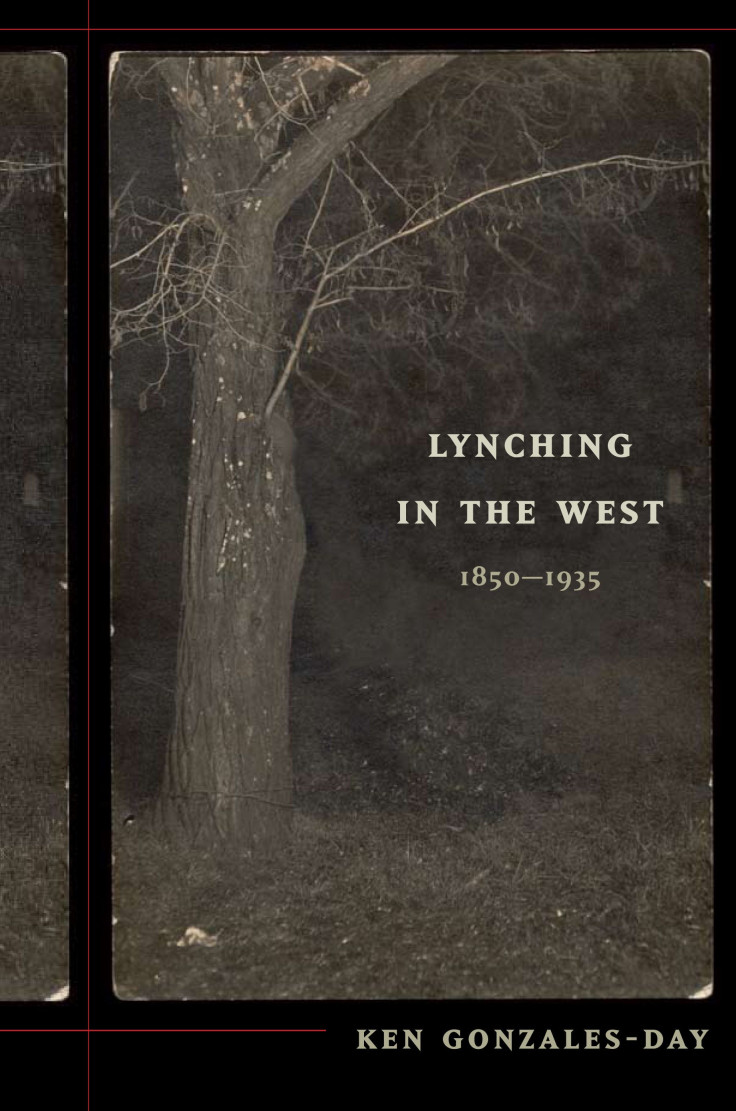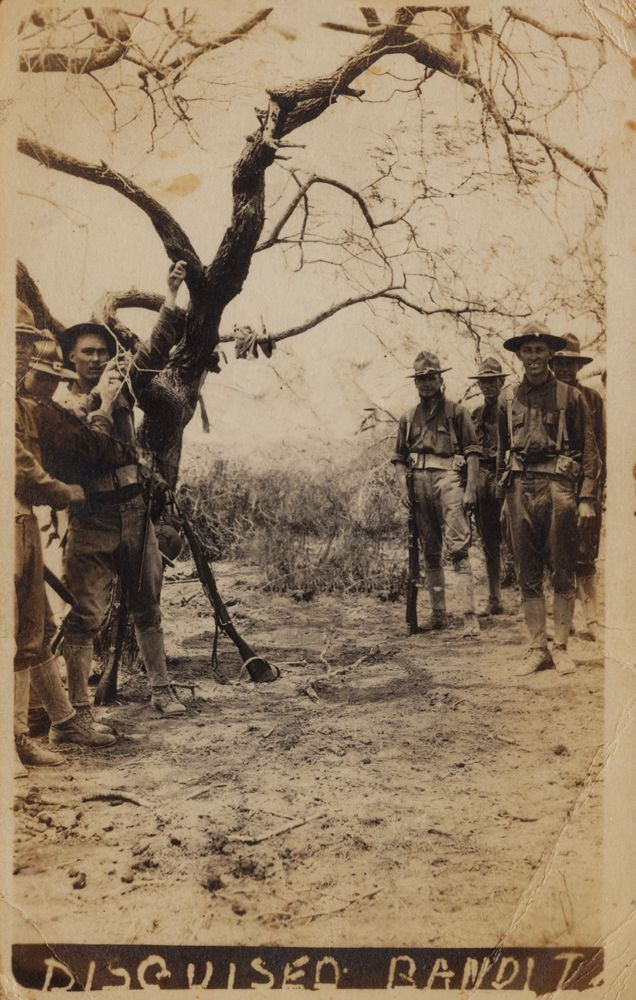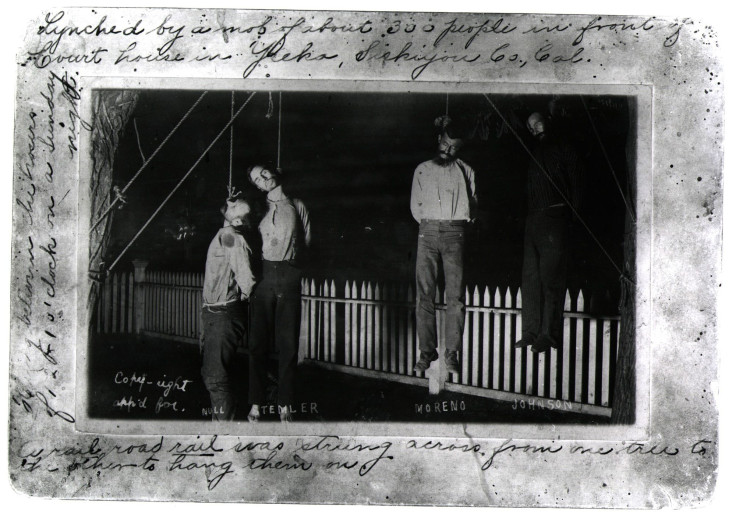
Discovering a Hidden History
Professor Ken Gonzales-Day hadn’t meant to write a book about lynching until he stumbled across a placid portrait of Rodolfo Silvas, an epically-bearded man who lived in California in the 1880s . When he turned over the card, he found a note identifying Silvas as the last man hanged in Los Angeles.
“I got the idea to find out what [that] actually meant,” said Gonzales-Day, in a phone interview with the Latin Times. The professor’s curiosity led to the writing of Lynching in the West: 1850-1935, a well-researched tome that treats both lynchings and their representations in photography. He also produced an art exhibition on those subjects. In one story from his book, which he says is typical, vigilantes in Santa Rosa lynched 3 men around midnight on December 10th, 1920.
“A mob of between 50 and 200 ‘masked’ men entered the city jail, overpowered the guards, and removed [...] the three men from the jail and [lynched] them to what was reported to have been an oak tree. [....] Three motionless bodies; [...] their names were George Boyd, Terrance Fitts, and Charles Valento, and they had just been lynched by a mob that was rumored to have included members of local law enforcement.”
“It’s like we’ve been brainwashed that this stuff is not important,” said Máximo Anguiano, in a phone interview with the Latin Times. Anguiano, a San-Antonio-based educator and self-styled "watchdog," wrote about lynching in a Tumblr post entitled The Unknown History of Latino Lynchings, in which he presented photos from Gonzales-Day’s recent art exhibition, “Erased Lynching,” which explores how Latino lynching has never received much attention from historians. He also quoted other scholars' lynching historiographies.
“[...] Mainstream [scholars] may have come across evidence of the practice but minimized it, instead focusing overwhelmingly on black lynching and slavery,” writes Richard Delgado in his article The Law of the Noose: A History of Latino Lynching, in the Harvard Civil Rights-Civil Liberties Law Review. “Still others might have failed to examine it out of sheer inertia.”
“I believe in art,” said Gonzales-Day, in reference to the Photoshopped images from “Erased Lynching,” in which the victims are subtly erased. “The erased images serve as a metaphor for the erasure of history. In his art exhibit, he didn’t want to re-represent and re-victimize Latino bodies. We should be able to have this conversation with me ‘showing you the body.’ People want to look at the body, get grossed out by the body, and then forget about it.”
In agreement with Gonzales-Day, the Latin Times decided to publish some of the original graphic lynching photos, which are features in the professor’s book. We have placed these images at the end of this article to accommodate readers who do not wish to view them.
Not Mob Violence; Police Violence
“As with blacks, Latino lynching went on with the knowledge and, in some cases, active participation of Anglo law enforcement authorities,” writes Delgado.
In fact, law enforcement were behind many of the lynchings that Gonzales-Day documents in his book. Police were often angry, he says, when they knew they didn’t have the evidence to convict someone, or when suspects were indirectly involved in the crime wouldn’t be eligible for the death penalty.
“In that particular [1920 Santa Rosa] case, there are some bad guys,” said Gonzales-Day. One of the Anglos, George Boyd, had shot multiple police officers. Angered at the deaths of their fallen brothers, police formed the core of a “vigilance committee.” Charles Valento, a Mexican American probably hadn't been involved, let alone done the actual killing.
“So they said, ‘one of the 3 guys had done the shooting. Other bought the gun, other bought the bullets,’” said Gonzales-Day. “By 1920 the lynching has become a way to mask violence,” and to circumvent the judicial process. There’s a myth, says the professor, there mobs were spontaneous. “But they weren’t,” and in many cases like the one in Santa Rosa, “the police is the mob. Or there is no mob.”
“In our history in Texas, the Texas Rangers were no different than the police are today,” said Máximo. “It is equivalent: the Texas Rangers were just doing their jobs, that these people needed to be ‘corrected.’ back then our [Latino] people had more connection to the indians, which were seen as ‘ungodly.’” The Texas Rangers, now an official state law enforcement agency, were an informal posse in the 19th century and a feeder organization for many of the “vigilance committees” and lynch mobs in California.
According to Professor Gonzales-Day’s book, Latinos were the largest group of lynching victims. Latinos represented 50% of all extrajudicial lynchings in California between 1850-1935, despite accounting for only around 20% of legal executions during the same period. But Latinos weren’t the only victims. Other groups that suffered heavily to lynching were Native Americans, as well as Chinese and other immigrants.
Also, Latinos sometimes participated in mixed-race mobs that lynched Asian and Mexican immigrants. More often than not these Latinos were more established, second, third, or fourth generation Californians. “They were afraid of what today would be the equivalent of undocumented immigrants,” said Gonzales-Day.
Modern-Day "Lynchings?"
In America as a whole, African Americans are disproportionately the victims of vigilante and police violence. Statistically, young black men are 21 times more likely to be killed by police than their white counterparts. In the past two years, this reality has moved to the headlines, most recently with alleged excessive-use-of-force cases that resulted in the deaths of Eric Garner and Michael Brown.
Yet back in the West, the Latino community has faced police brutality as well. In Denver, authorities and activists are at loggerheads over the recent police shooting and subsequent death of Jessica Hernandez. Her funeral was on Saturday. No police have been disciplined in her case, despite apparently acting in violation of DPD policy. Police say that 17-year-old Hernandez was behind the wheel of a stolen car, and allege that she drove the vehicle towards police.
Last year in Sonoma County, California, a sheriff shot and killed 13-year-old Andy Lopez, who was carrying a toy gun. Officials announced last year that they will not punish the officer involved.
“The law provides for a complete defense of anyone who defends himself or others,” said Sonoma District Attorney Jill Ravitch, explaining why her office would not charge the officer. She called the shooting "a reasonable response," given that the officer “honestly and reasonably” believed that he was in danger.
The Hernandez case, like the Lopez case and the Brown case, will likely revolve around whether or not the officers “believed” that they were in danger. It’s a more subtle legal loophole then the lynch mobs organized to kill 136 Valentos, and it’s helping police avoid prosecution for actions committed in plain sight, not behind masks. Lopez never “fired” his toy gun at the officers. Brown was clearly unarmed and walking on the street, the officer--Darren Wilson was in a car. Even if Wilson had been in danger, why didn’t he roll up the window, or drive on and call for backup?
“[Historical lynching cases] are absolutely relevant to modern cases,” said Gonazlez-Day, the photography professor. He cited the Santa Rosa case, in which Charles Valento was lynched for association with the man who pulled the trigger. As a minority, he was more easily swept up into the wrath of institutional violence which, according to reports, was guided by police.
“These [recent] police shootings are terrible and inexcusable, but not lynchings,” said Delgado, the legal scholar, in an email to the Latin Times. “They do have something in common with lynchings, however. They both are forms of social control.” After the sixties, said Delgado, “society” couldn’t rely on Jim Crow-era lynchings, so it turned to “criminal justice system, mass incarceration, and heavy-handed policing,” to “keep minority populations subjugated, afraid, and arrested.”
In the Hernandez case, Denver police have repeatedly defended their officers, while simultaneously refusing to release key facts of the case. Jessica Hernandez’s family has requested investigation into the shooting. In an official statement, the family blasted the Denver Police Department, while placing their conduct in the context of other police-on-minority violence.
“We are aware of the DPD’s history of conducting lengthy and fruitless investigations that serve only to exonerate its officers. We are dismayed that the DPD has already defended the actions of the officers and blamed our daughter for her own death, even while admitting they have very little information. In recent months, police killings have torn apart communities across this nation, and the unjustified shooting of our daughter is only the latest sign of an issue that requires federal oversight.”
Is police violence a form of institutionalized racism meant to oppress minorities? Are weak use-of-force investigations just examples of police protecting their fellow officers? Regardless of the answer to these questions, one thing is clear: the Latino community does not trust the police.
Afterward: Can Police Restore Trust Within The Latino Community?
In a recent study, Pew Hispanic found that while Latinos don’t trust police as much as whites and, like African Americans, fear for the safety of crime suspects.
“Six-in-ten (61%) Hispanics say they have a great deal or a fair amount of confidence that the police in their local communities will do a good job enforcing the law, compared with 78% of whites and 55% of blacks. Just under half (46%) of Hispanics say they have confidence that police officers will not use excessive force on suspects, compared with 73% of whites and 38% of blacks.”
How can law-enforcement agencies restore trust? Some have proposed having all officers wear cameras while on duty. Others believe that federal oversight and increased training could help.
In the Latino community, policing has to take into account the problems of policing undocumented residents. For years, law-enforcement have worked with Immigration and Customs Enforcement to net undocumented immigrants for deportation. In the worst cases, it’s meant that victims of crime have faced deportation as a result of asking the police for help, or cooperating with police to help catch criminals. Here’s a story of one such victim, as told by the the American Civil Liberties Union (ACLU), a lobby group and legal aid organization.
“On the evening of June 28, 2012, Claudia Valdez called the police for help. An argument with her husband at the time had turned physical and she feared for her safety and that of her three young children. She ran to her neighbor’s house with her kids in tow and asked for help.”
According to the ACLU, Valdez was arrested on a domestic violence charge which was promptly dropped. Yet because she was undocumented, the local sheriff held her for 3 days so that ICE could check her immigration status and consider deporting her.
“Ms. Valdez’s experience underscores the damage to public safety and community trust that results when victims of crime fear that any contact with law enforcement will be the first step in a seamless transfer to jail and then to immigration proceedings,” said ACLU of Colorado Staff Attorney Rebecca Wallace.
Since 2012, the Obama Administration has scaled back programs like Secure Communities that led to more arrests and deportations. Also, a long-standing program within U.S. immigration offers a special “U-Visa” for victims of crime and those who report to law enforcement. Congress has capped the program at 10,000, and according to a statement from U.S. Citizenship and Immigration Services the backlog has reached 45,898. Being on the waiting list is better than being undocumented. “Eligible wait-listed petitioners are granted deferred action and are eligible to apply for work authorization,” said a USCIS representative in an email to the Latin Times.
The history of Latino lynching and the present situation of poorly-policed minority communities may boil down to a few questions: what goes through the mind of an undocumented mother deciding whether or not to dial 9-1-1? What emotion does a young Latino in Denver feel when a police car pulls up beside her? Sheriff Arpaio, the Latino-hating polemic from Arizona, may still have a job, but at least he's been outed by the Justice Department. Programs like the U-Visa may be ineffective, but at least they exist. As activists, federal reformers, and local law enforcement continue to evolve, minorities may reach the antipode of lynching; full inclusion and confidence in the institutions of justice.
WARNING: graphic images of dead lynching victims are shown below.




Revisions 2/11/2015: this article was revised to update Anguano's profession. He is an educator and self-styled watchdog, not a blogger. Other revisions for typos and clarity.
© 2025 Latin Times. All rights reserved. Do not reproduce without permission.



